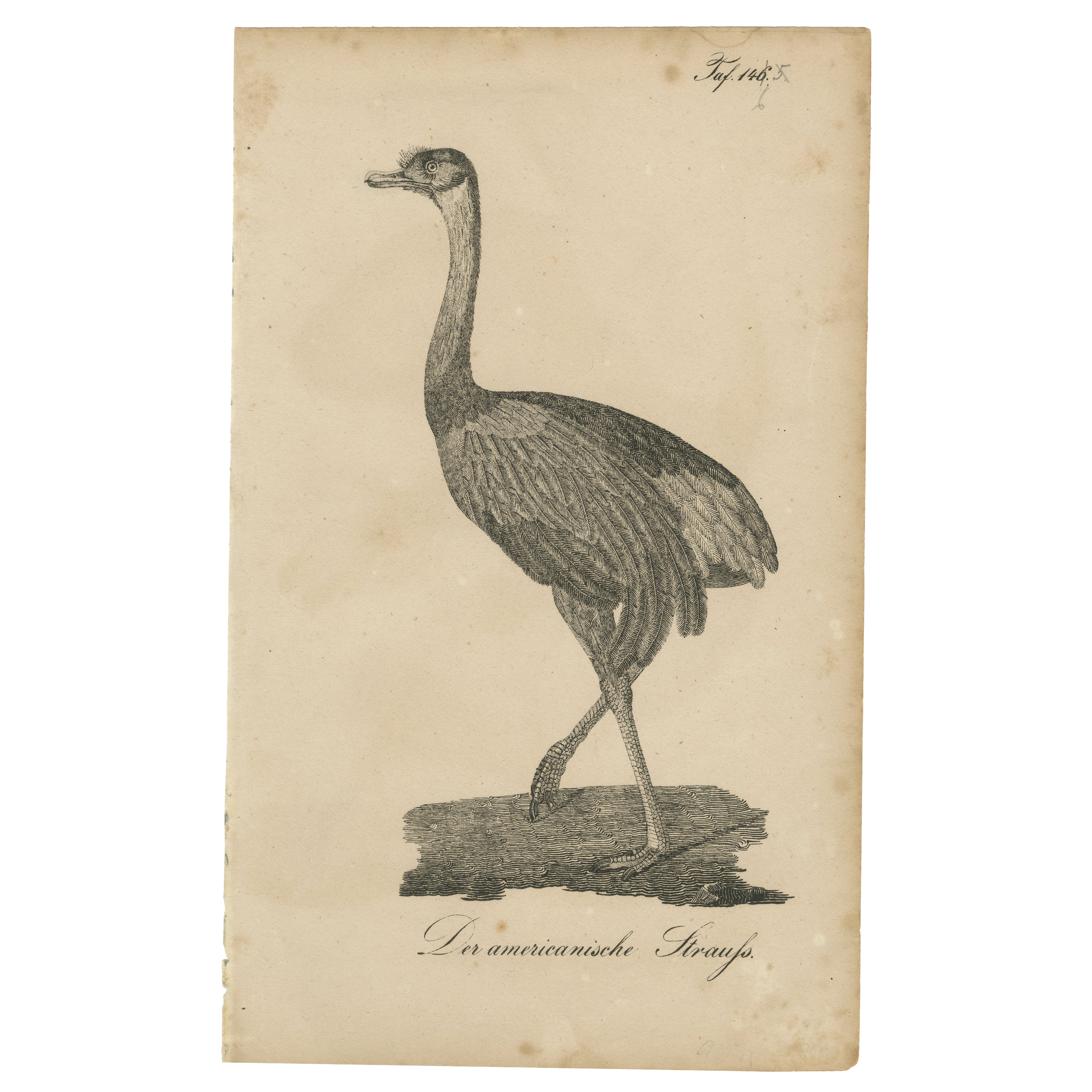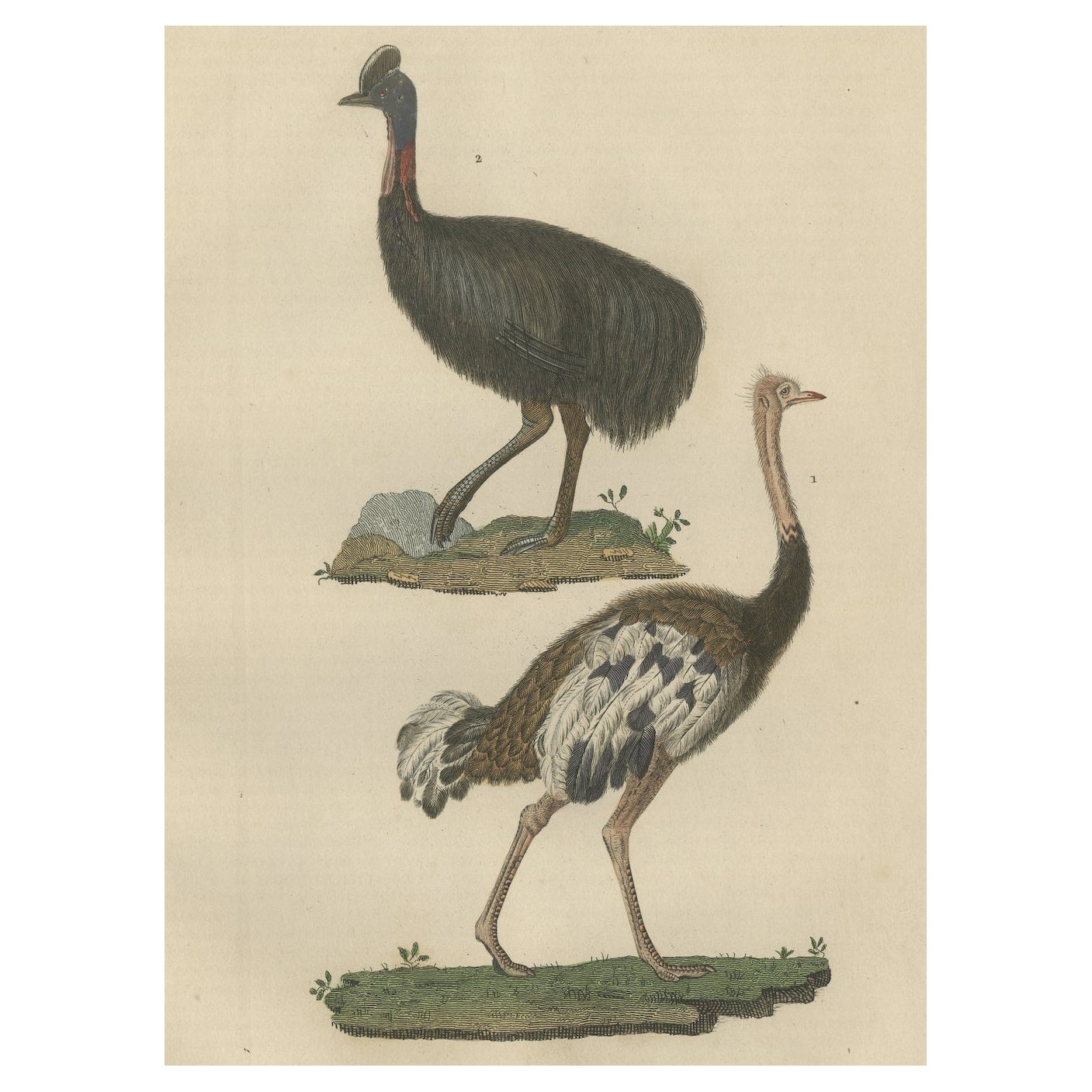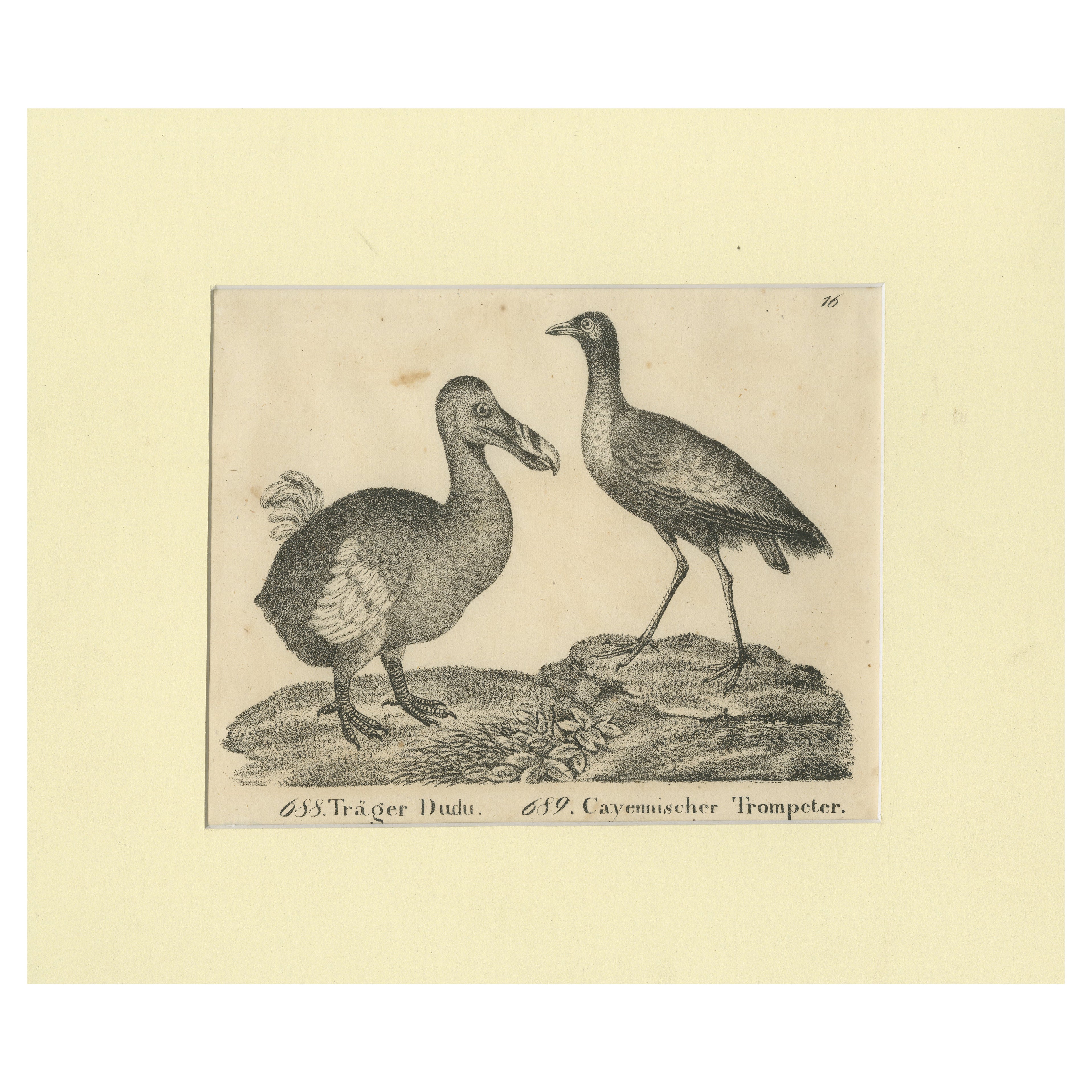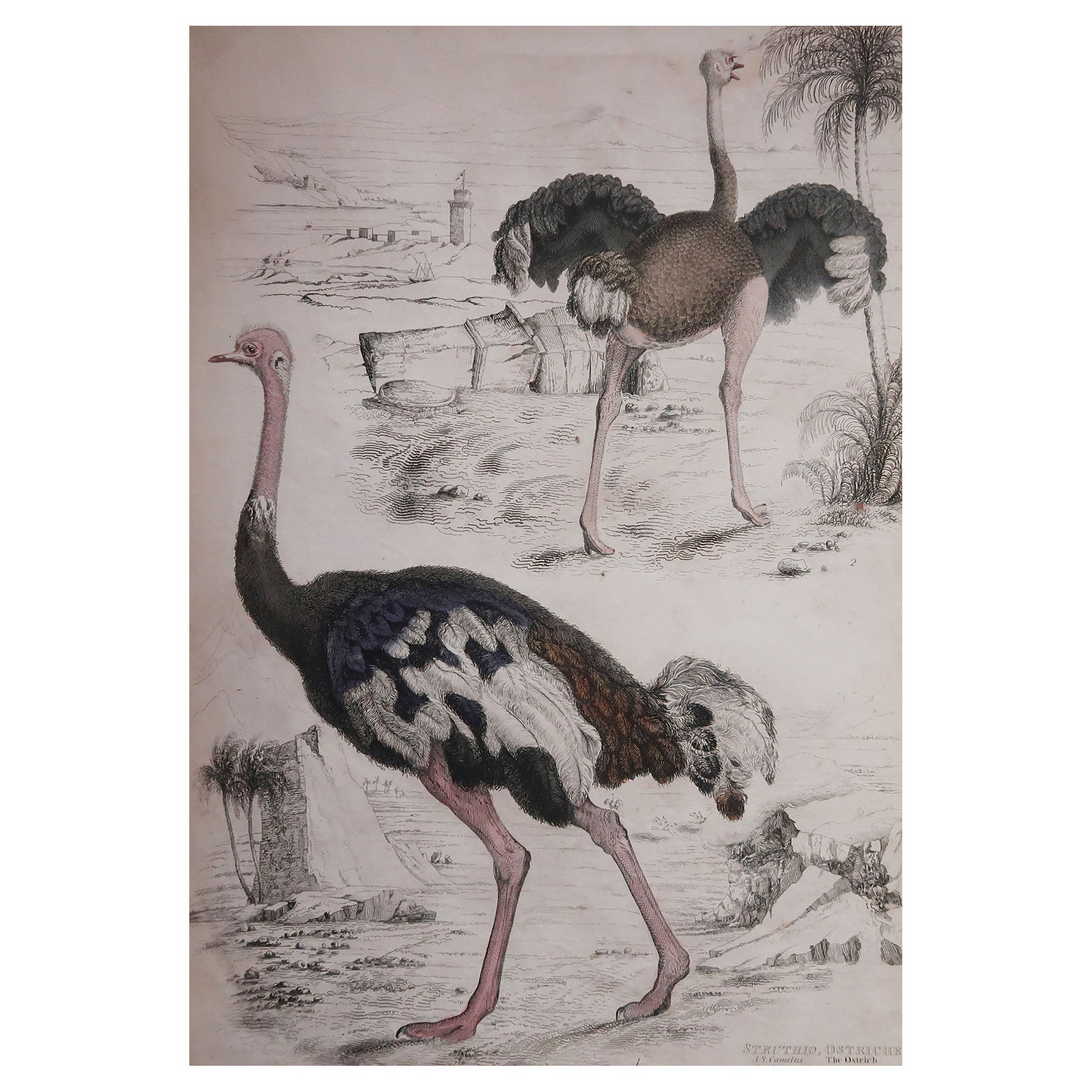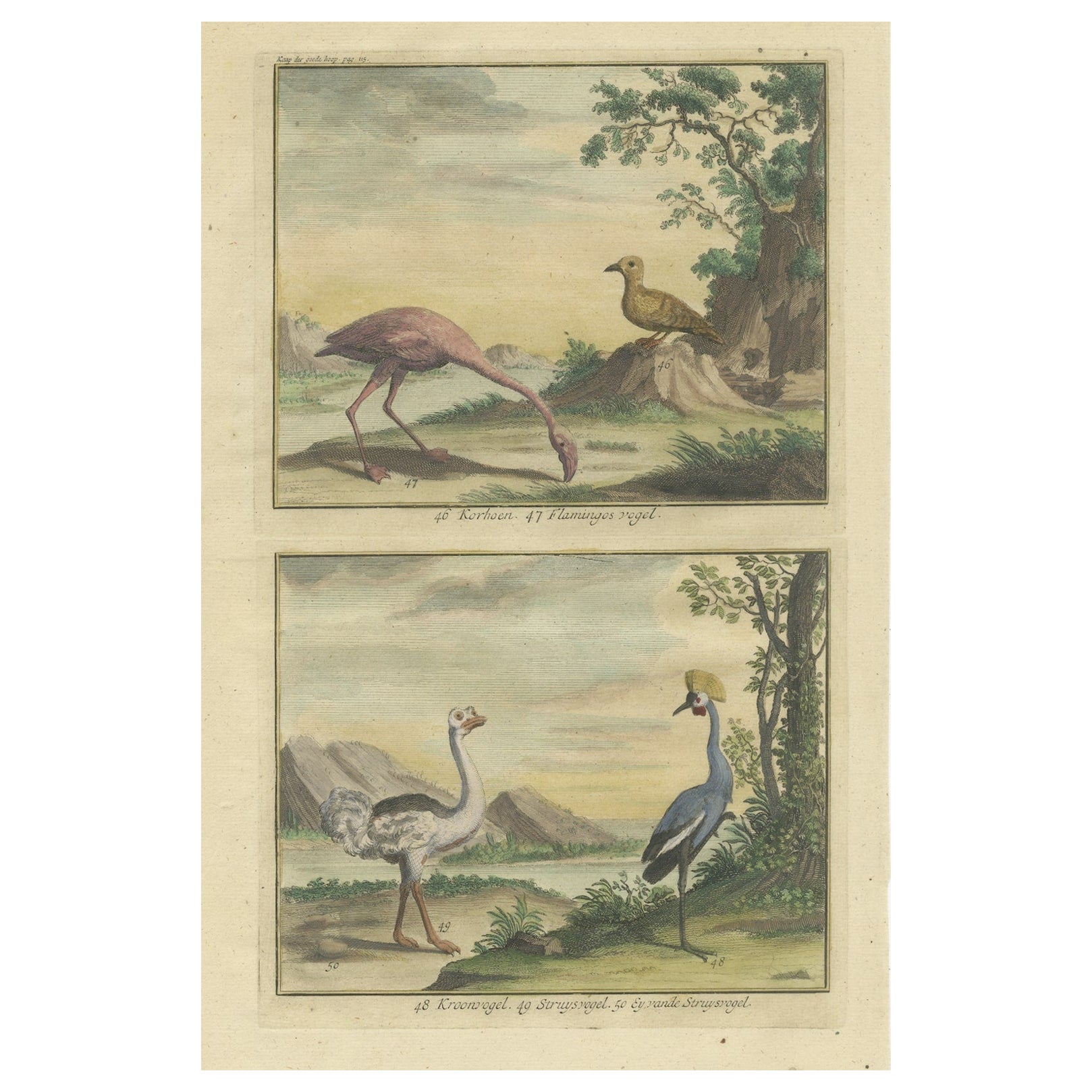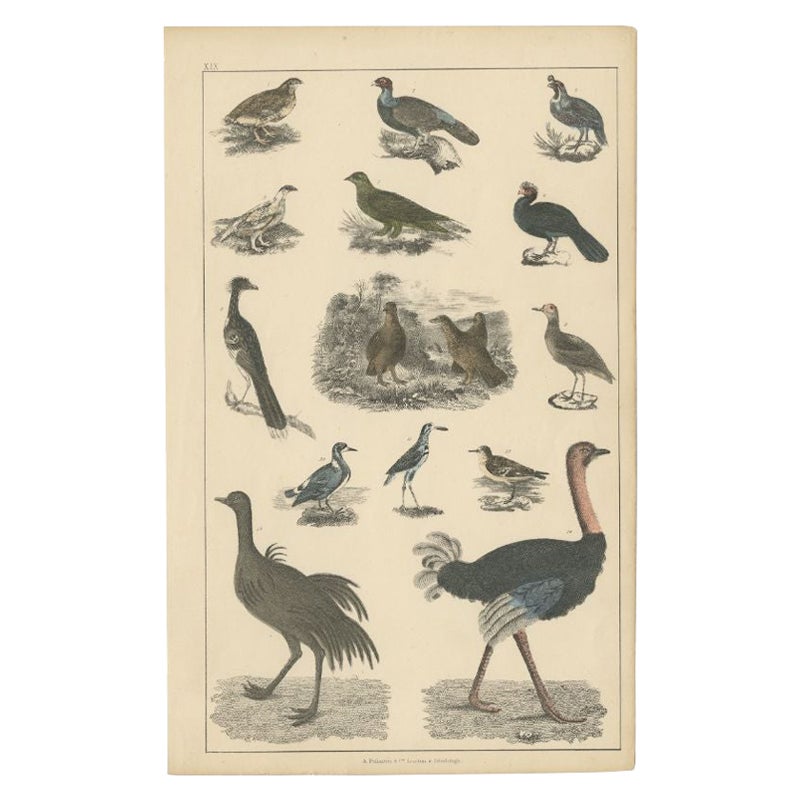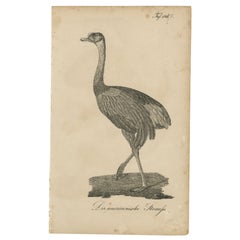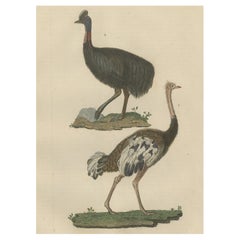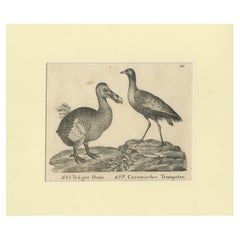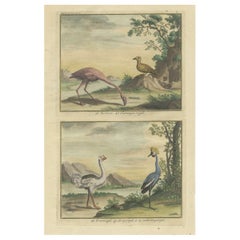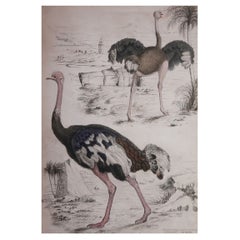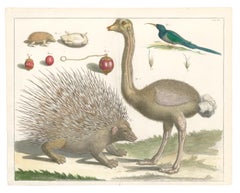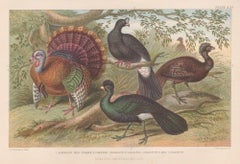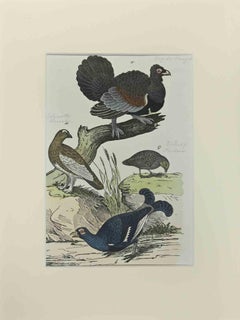Items Similar to Rare Copperplate Engraving of the Extinct Dodo and an Ostrich, 1805
Want more images or videos?
Request additional images or videos from the seller
1 of 10
Rare Copperplate Engraving of the Extinct Dodo and an Ostrich, 1805
$439.85
$586.4725% Off
£324.46
£432.6125% Off
€367.50
€49025% Off
CA$609.43
CA$812.5825% Off
A$661.73
A$882.3025% Off
CHF 350.43
CHF 467.2425% Off
MX$8,110.86
MX$10,814.4825% Off
NOK 4,336.74
NOK 5,782.3225% Off
SEK 4,097.99
SEK 5,463.9825% Off
DKK 2,797.73
DKK 3,730.3025% Off
About the Item
1805 Copperplate Engraving of Dodo and Ostrich from Abraham Rees' Cyclopaedia
This rare and finely detailed copperplate engraving, created by T. Milton after an illustration by the renowned Sydenham Edwards, is a stunning piece of 19th-century natural history art. It was originally published in Abraham Rees' *Cyclopaedia or Universal Dictionary of Arts, Sciences, and Literature* in London, 1805.
The engraving prominently features the extinct Dodo (Raphus cucullatus), a flightless bird native to Mauritius that became a symbol of human-driven extinction. The dodo is depicted with its iconic plump body, curved beak, and robust legs, offering a glimpse into the natural history of a species lost to time. Alongside the dodo are male and female Ostriches (Struthio camelus), the largest living birds, rendered with exquisite detail, showcasing their striking plumage and characteristic postures.
Antique copper plate engraving from "The Cyclopædia: or, Universal dictionary of arts, sciences, and literature" by Abraham Rees, published in the early 19th century. The engraving features illustrations of two notable bird species, the dodo and the ostrich, classified under the order 'Gallinae' according to Linnaean taxonomy.
Echoes of Avian Majesty: The Dodo and Ostrich of the Early 19th Century. This also would have been a good title, one that pays homage to the grandeur of these birds, with the dodo being an emblem of extinction and the ostrich representing the grand scale of birds still walking the Earth. It also reflects the time period and the scientific interest in ornithology.
More facts about the Dodo explaining why the Dodo prints are so popular with collectors of antique prints:
The dodo is a bird that has become an icon of extinction. Its story is a sad tale of the impact of human activity on the environment and the species that inhabit it.
Discovery and Description:
The dodo (Raphus cucullatus) was a flightless bird that lived on the island of Mauritius in the Indian Ocean. It was first discovered by Dutch sailors around 1598. The bird was about one meter tall and weighed about 10-18 kilograms (20-40 pounds). It had a large beak, a plump body, small wings, and stout, yellow legs.
Extinction:
The dodo's extinction is attributed to a combination of human exploitation and introduced species. Being flightless and having evolved without any natural predators, the dodo was not fearful of humans. This, along with its inability to fly, made it an easy target for the sailors who would hunt it for food. Additionally, the introduction of animals such as pigs, rats, and monkeys by humans led to increased competition for food resources and predation of dodo eggs and young.
Cultural Impact:
The dodo became extinct in the late 17th century, less than 100 years after it was discovered. It is often used as a cautionary example of how human intervention can inadvertently lead to the demise of a species. The term "dodo" has since become synonymous with anything outdated or destined for failure or obsolescence.
Scientific Importance:
In a scientific context, the dodo has been the subject of much interest and study. The lack of complete dodo specimens has made it difficult for researchers to fully understand its behavior, ecology, and exact appearance. However, the discovery of subfossil remains has allowed for some reconstruction of its physical form and genetics.
Cultural Representation:
Culturally, the dodo remains a fixture in literature and popular culture, most famously appearing in Lewis Carroll's "Alice's Adventures in Wonderland," which helped cement its image in the public imagination.
The story of the dodo serves as a poignant reminder of the vulnerability of isolated ecosystems to human impacts and has informed conservation efforts for other species at risk of extinction.
This plate exemplifies the synthesis of art and science in early 19th-century publications, providing both aesthetic and educational value. The detailed illustration and expert craftsmanship highlight the scientific rigor and artistic skill that went into Rees' monumental work.
Condition: The engraving is in excellent condition for its age, with crisp detailing and only minimal signs of toning or foxing typical of historical prints. Lower border a bit cut short, otherwise fine for framing.
This exceptional engraving is a must-have for collectors of natural history, antique prints, or those seeking to own a tangible piece of the past. It would make a striking addition to any collection or serve as a unique statement piece for display.
Secure worldwide shipping available.
- Dimensions:Height: 10.48 in (26.6 cm)Width: 8.27 in (21 cm)Depth: 0.01 in (0.2 mm)
- Materials and Techniques:Paper,Engraved
- Period:
- Date of Manufacture:1805
- Condition:Condition: The engraving is in excellent condition for its age, with crisp detailing and only minimal signs of toning or foxing typical of historical prints. Lower border a bit cut short, otherwise fine for framing.
- Seller Location:Langweer, NL
- Reference Number:Seller: BG-140371stDibs: LU3054343020682
About the Seller
5.0
Recognized Seller
These prestigious sellers are industry leaders and represent the highest echelon for item quality and design.
Platinum Seller
Premium sellers with a 4.7+ rating and 24-hour response times
Established in 2009
1stDibs seller since 2017
2,622 sales on 1stDibs
Typical response time: <1 hour
- ShippingRetrieving quote...Shipping from: Langweer, Netherlands
- Return Policy
Authenticity Guarantee
In the unlikely event there’s an issue with an item’s authenticity, contact us within 1 year for a full refund. DetailsMoney-Back Guarantee
If your item is not as described, is damaged in transit, or does not arrive, contact us within 7 days for a full refund. Details24-Hour Cancellation
You have a 24-hour grace period in which to reconsider your purchase, with no questions asked.Vetted Professional Sellers
Our world-class sellers must adhere to strict standards for service and quality, maintaining the integrity of our listings.Price-Match Guarantee
If you find that a seller listed the same item for a lower price elsewhere, we’ll match it.Trusted Global Delivery
Our best-in-class carrier network provides specialized shipping options worldwide, including custom delivery.More From This Seller
View AllGreater Rhea, "American Ostrich" Engraving, German Natural History, c.1780s
Located in Langweer, NL
Greater Rhea, "American Ostrich" Engraving, German Natural History, c.1780s
Antique German engraving titled “Der americanische Strauß” (The American Ostrich), plate number Taf. 146....
Category
Antique 1780s German Prints
Materials
Paper
Decorative Old Hand-Colored Bird Print of an Ostrich and Cassowary
Located in Langweer, NL
Title: ‘1. STRUTHIO CAMELUS – AUTRUCHE, 2. CASUARIUS GALEATUS – CASOAR.’
Translated: 1. OSTRICH, 2. CASSOWARY.’
Engraving with original hand colouring, heightened with arabic gum o...
Category
Antique 1840s Prints
Materials
Paper
$181 Sale Price
20% Off
Antique Print of The Extinct Dodo and the Trumpeter Bird, 18th Century
Located in Langweer, NL
Antique Print of Dodo and Trumpeter Bird, Plate 688–689, c. 18th Century
This antique ornithological engraving features two rare and historically significant bird species: the “Träg...
Category
Antique Late 18th Century Prints
Materials
Paper
Old Engraving of a Black Grouse, Flamingo, Ostrich and Common or Crested Crane
Located in Langweer, NL
The hand-colored engraving features a selection of birds, each intricately detailed and labeled in Dutch.
At position 46, the "Korhoen" (or Black Grouse) is depicted, showcasing it...
Category
Antique 1720s Prints
Materials
Paper
$153 Sale Price
20% Off
Antique Bird Print of Various Bird Species, Incl an Ostrich, c.1852
Located in Langweer, NL
Untitled bird print featuring various bird species. This print originates from 'A History of the Earth and Animated Nature' by O. Goldsmith. Goldsmith's Animated Nature went through ...
Category
Antique 19th Century Prints
Materials
Paper
Antique Bird Print of an Ostrich, Toucan, Pelican and Other Birds, 1808
Located in Langweer, NL
Antique bird print of the A) ostrich B) crowned-crane C) partridge (?) D) toucan E) ? F) goose, rooster etc. G) charadriiformes species H) pelican I) penguin K) bittern L) cassowary....
Category
Antique Early 19th Century Prints
Materials
Paper
$239 Sale Price
20% Off
You May Also Like
Large Original Antique Natural History Print, Ostriches, circa 1835
Located in St Annes, Lancashire
Great image of ostriches
Unframed. It gives you the option of perhaps making a set up using your own choice of frames.
Lithograph after Cpt. Brown with original hand color.
...
Category
Antique 1830s English Folk Art Prints
Materials
Paper
Ostrich, Porcupine and Hedgehog Engraving
By Albertus Seba
Located in New York, NY
Original engraving with later hand-coloring from "Locupletissimi rerum naturalium thesauri accurata descriptio, et iconibus artificiossimis expressio, per universam physices historia...
Category
1730s Animal Prints
Materials
Laid Paper
$875 Sale Price
27% Off
American Wild Turkey and Curassows, English antique bird engraving print, 1879
Located in Melbourne, Victoria
American Wild Turkey and Curassows
Wood-engraving with original colouring. 1879.
160mm by 245mm (sheet).
Key below the image. From Oliver Goldsmith's 'A History of the Earth and...
Category
Late 19th Century Victorian Animal Prints
Materials
Engraving
Wood Rooster - Etching by Johann Friedrich Naumann - 1840
Located in Roma, IT
Wood Rooster is an Etching hand colored realized by Gotthilf Heinrich von Schubert - Johann Friedrich Naumann, Illustration from Natural history of birds in pictures, published by St...
Category
1840s Modern Figurative Prints
Materials
Etching
Woman Artist-Madame Pauline Knipp Engraving of an Exotic Pigeon
Located in Downingtown, PA
Madame Pauline Knipp engraving of a pigeon,
From Les pigeons par Madame Knip, ne´e Pauline de Courcelles ; le texte par C.J. Themminck,
Plate 2,
Paris 1809-1811.
A remarkable ...
Category
Antique Early 19th Century French Regency Prints
Materials
Paper
The Rooster - Etching by Johann Friedrich Naumann - 1840
Located in Roma, IT
The Rooster is an Etching hand colored realized by Gotthilf Heinrich von Schubert - Johann Friedrich Naumann, Illustration from Natural history of birds in pictures, published by Stu...
Category
1840s Contemporary Figurative Prints
Materials
Etching
More Ways To Browse
Dodo Bird
Glass World Globe
Gloria Vanderbilt Vintage
Gold Vesta
Golden Egg Vintage
Gondola Glass
Gp J Baker
Grand Tour Portrait
Grape Stand
Green Man Carved
Guler Elci
Gustavian Green
Hampshire Antique Furniture
Hand Blown Gold Glass Decanter With Glasses
Harlem Furniture
Harold Schwartz For Romweber Furniture
Helen Hobey Baker
Helen Hobey
